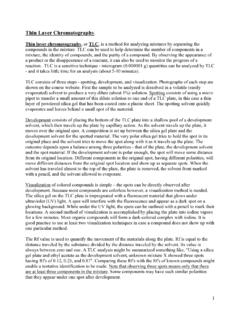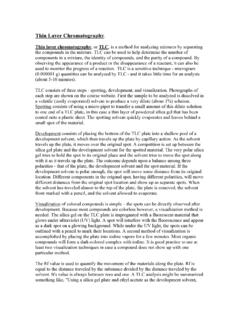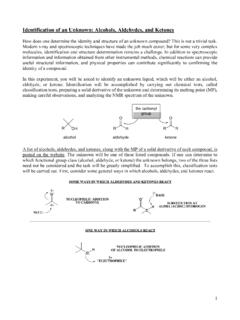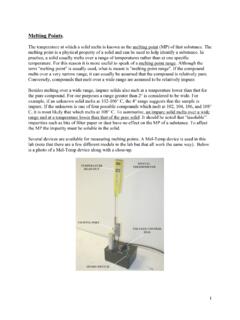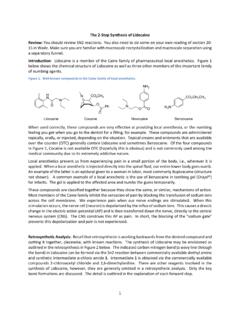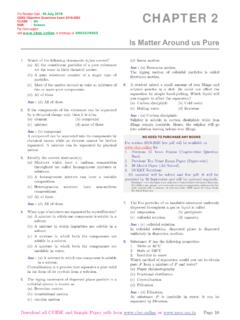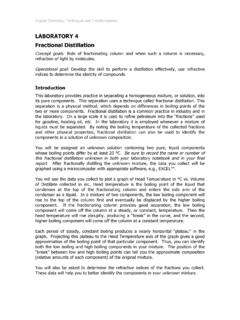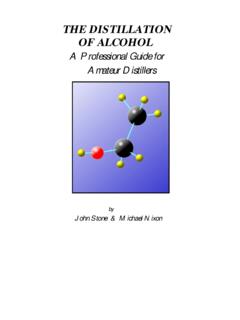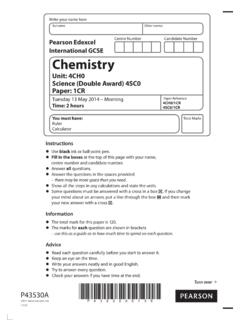Transcription of Synthesis of Cyclohexene The Dehydration of Cyclohexanol
1 1 Synthesis of Cyclohexene The Dehydration of Cyclohexanol . The general approach towards carrying out an organic reaction: (1) Write out the balanced reaction, using structural formulas. (2) Construct a table of relevant information for reactants and products , MPs, BPs, MWs, densities, hazardous properties. (3) Calculate the correct molar ratios of reactants. Convert moles to grams and milliliters. (4) Mix correct amounts of reactants, solvents, catalysts in correct order to give specific concentrations. Possibly heat or cool or irradiate with UV light, allow to react for necessary amount of time, possibly follow reaction progress using chromatography ( , TLC, GC) or spectroscopy ( , IR, NMR). (5) After reaction is complete, the reaction mixture is usually a complex mixture of desired product(s), byproducts, unreacted starting materials, solvents, and catalyst.
2 Product may be light, heat, or air (O2) sensitive. (6) Separation and purification steps (so-called reaction work-up). Some combination of extractions, distillations, recrystallizations, chromatography, etc are used for the work-up. (7) Identify product(s) using spectroscopy (IR, NMR, etc), chromatography (GC, TLC, etc), physical properties (MP, BP, etc), and occasionally chemical tests. Cyclohexene . In the presence of a strong acid, an alcohol can be dehydrated to form an alkene. The acid used in this experiment is 85% phosphoric acid and the alcohol is Cyclohexanol . The phosphoric acid is a catalyst and as such increases the rate of reaction but does not affect the overall stoichiometry. It can be seen from the balanced reaction that 1 mole of alcohol produces 1 mole of alkene. The theoretical yield of alkene in moles is therefore equal to the number of moles of alcohol used.
3 OH85% H3PO4+HOHheat Mechanism. 2 The first step in the mechanism is protonation of the alcohol group by the acid (slightly exothermic). The second step is the loss of water to form the carbocation (highly endothermic). The final step is removal of a beta hydrogen by base (water) to form the alkene (exothermic). The overall reaction is slightly endothermic. General Approach. The reaction is carried out in a fractional distillation apparatus. As the alcohol and acid are heated, alkene and water are produced and co-distill into a collection vial. As in any distillation , unless precautions are taken, some of the product will be lost as hold-up in the apparatus. Hold-up would result in a reduced yield of product. To overcome this problem and to ensure that a maximum amount of product is distilled, a higher boiling "chaser" solvent is added to the distillation flask and the distillation is continued until the temperature rises well over the BP of Cyclohexene .
4 At this point it can be assumed that all product has distilled into the collection vial, along with some chaser. 3 The collection vial now contains Cyclohexene , water, toluene, and small amounts of other impurities. Because any water present will interfere with the distillation (water will co-distill and will not separate), prior to a final distillation , to obtain pure product, all water must be removed. This is done in two steps. First, the sample is mixed well with an aqueous saturated sodium chloride solution (sat d salt) and the lower aqueous layer is removed and discarded. This is a pre-drying step that removes most of the water. Next, anhydrous calcium chloride pellets are added. Anhydrous CaCl2 is an inorganic drying agent that binds strongly with water and thus removes any traces of water from the solution. After about five minutes, the solution is separated from the pellets and transferred to the clean and dry fractional distillation apparatus.
5 The dried solution is then fractionally distilled to produce purified Cyclohexene . To achieve optimal separation, the distillation must be done at a slow steady rate. To ensure that the fraction collected as product is relatively pure Cyclohexene , this fraction is collected over a narrow range at the boiling point of Cyclohexene . The purity of the Cyclohexene is determined by gas chromatographic (GC) analysis and a % yield calculated. 4 Chemical Tests. The presence of the alkene functional group can be indicated by carrying out simple reactions in which a color change can be observed. One such reaction is with bromine in dichloromethane. The bromine reagent is a reddish-orange color. When it is dripped slowly into a sample of alkene, the bromine reacts with the alkene to form a nearly colorless dibromide. Because the bromine is consumed, the mixture loses the reddish-orange color.
6 If a sample decolorizes bromine under these conditions it can be inferred that an alkene functional group is likely present. BrBrBr2 A second color test is the reaction with potassium permanganate. An alkene reacts with potassium permanganate to form a colorless diol. Under acid conditions the diol reacts further to form a mixture of colorless carboxylic acids or in the case of a cyclic alkene, a dicarboxylic acid. As the permanganate is consumed, the mixture loses its deep purple color. At the same time manganese dioxide, a brown precipitate, forms. If a sample decolorizes permanganate and forms a brown precipitate it can be inferred that an alkene functional group is present. OHOHKMnO4 COOHCOOH Procedure. (rev 6/10) During Weeks 2 and 3 of lab, you will do two experiments - Cyclohexene and Melting Points (MPs). Because of a limited number of melting point devices and gas chromatographs, one half of the class will do Cyclohexene during the 2nd week and the other half will do MPs.
7 During Week 3, you will switch and do the experiment that you did not do during Week 2. The experiment that you will do during Week 2 will be posted on the web. Be sure to prepare for the correct experiment. Melting Points are described in a separate handout. The " Things to Watch Out For In Distillations" listed for the distillation experiment are common to this distillation as well - review them carefully. As always, use care when inserting the thermometer into the thermometer adaptor. Hold the thermometer close to the adaptor and push and twist gently away from you. Breakage could result in a serious injury. Check for frayed connectors and cracked flasks. Cyclohexene has a disagreeable odor, characteristic of volatile alkenes. Allow the apparatus to cool before disassembling it in the fume hood, and dispose of the wastes in the hood in the ORGANIC LIQUID WASTE CONTAINER.
8 Rinse the apparatus in the waste hood with a SMALL AMOUNT of acetone and dispose of that in the ORGANIC LIQUID WASTE CONTAINER. CAUTION: Cyclohexene is very flammable. Handle phosphoric acid with care. It is corrosive to tissue. If your skin comes into contact with phosphoric acid, wash the contaminated area immediately with water, then soap and water. Clean up spills immediately using the sodium bicarbonate in the hood. Prepare a flow diagram including all steps in the reaction, work-up, and identification. Prepare a table of reagents, products, and byproducts. (Sample of each on Chem 269 website handouts page.) Preparation of Cyclohexene . As always, if the sand bath is being used in an experiment, turn it on right away to a setting of just under 40. This way it will reach operating temperature by the time it is needed.
9 In this experiment the phosphoric acid need not be measured very accurately. However, the 5 amount of Cyclohexanol determines the theoretical amount of product so it must be measured accurately. Place the round-bottomed (rb) flask into a 30 mL beaker to hold it upright, set this onto the balance and press zero (this will set the weight of the container to zero this is called taring the flask), and measure in about g ( g, but weigh it exactly, , g or g) of Cyclohexanol by dropping it in with a pipet. Using a buret in the hood, add about mL of 85% phosphoric acid to the rb flask. Note that the rb flask becomes warm - addition of acid to alcohol is exothermic. Set up a fractional distillation apparatus in the same way as in the distillation experiment (remember the boiling chips). Be sure to use the distillation column (in some rare cases a slightly longer narrower glass tube that looks a lot like the distillation column may have inadvertently gotten mixed in to some of the lockers.)
10 Be sure to not use this tube - this tube, a chromatography column used in another course, does not connect tightly.) Use the black plastic connector to connect the flask to the distilling head. This is more resistant to the reactants than is the white connector. Insulate the column by loosely wrapping it with a piece of aluminum foil. Be sure to use an ice-cooled receiver. Otherwise product will evaporate and the odor will be disagreeable. Heat the mixture sufficiently to distill product over into the collection vial (remember to make a small depression in the sand bath so that the flask may be lowered into it for effective heating). Unlike in a normal distillation this first distillation can and should be done fairly rapidly, not at the usual rate of one drop per 20-30 seconds, but instead at a rate of about one drop per second or two.


